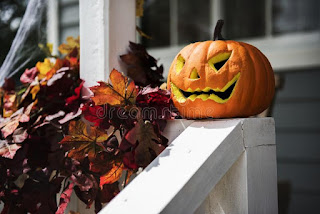Reclaiming the spooky and eerie on All Hallows' Eve
------
Perhaps it is because I love the season of Autumn that I particularly enjoy All Hallow's Eve. It is a time of Autumnal festivity: the pumpkins, the apples, the nuts are reminders of the bounty of this season. Harvest Thanksgiving, however, is now past. The glow of early Autumn has gone and while Winter has not yet arrived, we feel its approach. The days darken, the trees have lost their leaves, and the mornings are colder.
It seems natural in such a time, when the bare branches of trees are illumined by the late afternoon sunset or by moonlight on a quiet evening, that spooky stories should accompany the pumpkins and apples. Stories that make us wonder as we pass the old graveyard or hear the leaves rustle behind us during a twilight walk.
For some Christians, however, All Hallows’ Eve - despite being rooted in the Church’s celebration of All Saints’ Day on 1st November - is to be rejected as a celebration of darkness. Spooky stories, ghosts, witches, and goblins: these need to be banished by the light.
It seems odd that Christians would reject these when Scripture itself has its spooky, Gothic elements. The strange account of the witch of Endor is hardly a straightforward rehearsal of the condemnation of such activity in Leviticus. Ezekiel's vision of the dry bones makes a Hallowe'en skeleton costume look incredibly tame. Matthew's account of the graves opening at the death and resurrection of Christ, when the departed "went into the holy city, and appeared unto many", has a deeply haunting quality. And then there is Eliphaz in the Book of Job, telling of a ghostly encounter: "In thoughts from the visions of the night, when deep sleep falleth on men, Fear came upon me, and trembling, which made all my bones to shake. Then a spirit passed before my face; the hair of my flesh stood up".
To reject the spooky and the ghostly is to overlook the presence of such elements in Scripture, elements that are meant to unsettle us, to prod and poke at safely materialist assumptions, assumptions that close us to realities unseen, realities beyond the physical.
To be clear, this is not to affirm the tasteless commercial celebration of gore that can now accompany Hallowe’en. And it certainly is not to overlook the traditional exhortations against practices which deny or undermine the Christian vision of the resurrection of the body and the life everlasting. It is, however, to suggest that a Christian rejection of the spooky and ghostly character of All Hallow’s Eve does not aid the Church’s witness and cultural presence.
‘Light parties’ - fashionable amongst some Christians as an alternative to All Hallow’s Eve - too easily become a rather bland attempt to sanitise and make ‘safe’ that which is meant to unsettle us. What is more, they ignore the cultural desire for such stories, a desire arising from a perception that we should be unsettled by things unseen.
That a secular culture should celebrate Hallowe’en with some enthusiasm is a reminder that secularism and materialism are deeply unsatisfying ideologies. We continue to wonder as we pass the old graveyard or hear the leaves rustle behind us during a twilight walk. We continue to wonder about things unseen, not least when the dark days of the year arrive. Just as the ghostly and the spooky in Scripture prods and pokes at comfortable assumptions, so too should Christians embrace the ghostly and the spooky on All Hallow’s Eve. The Church should offer not a bland rejection of the eerie but, rather, a confident, seasonal celebration of the spooky and ghostly, hints and signs of the truth and reality of things unseen.




Comments
Post a Comment